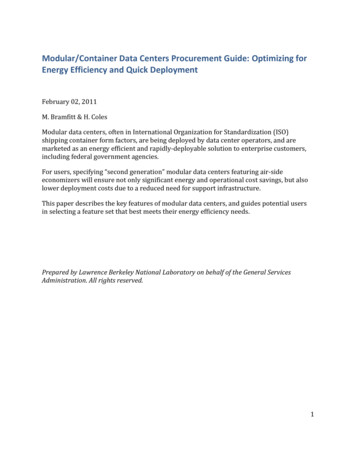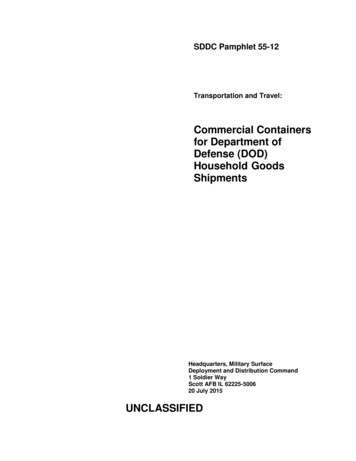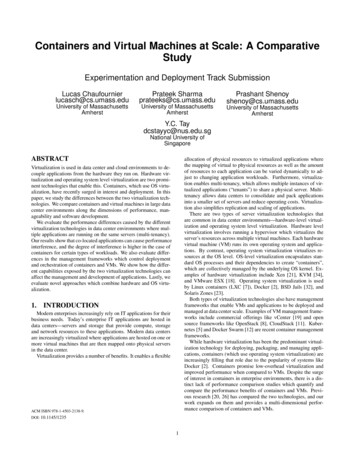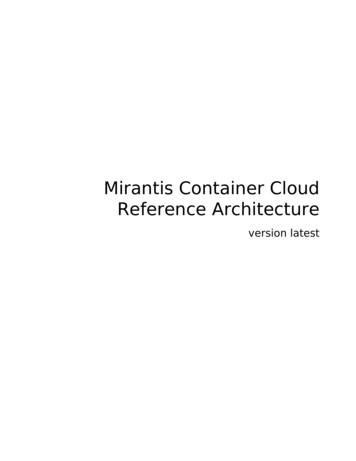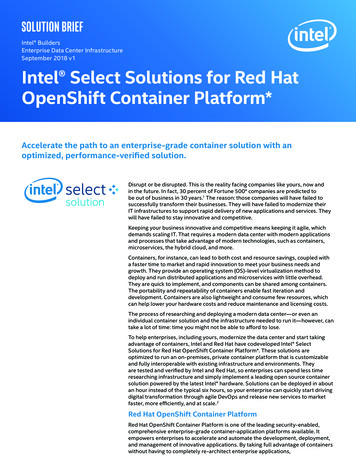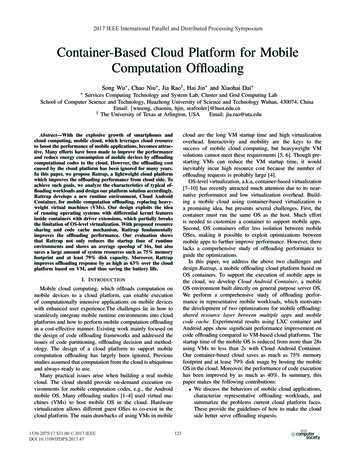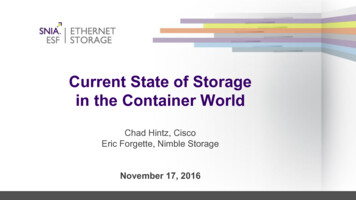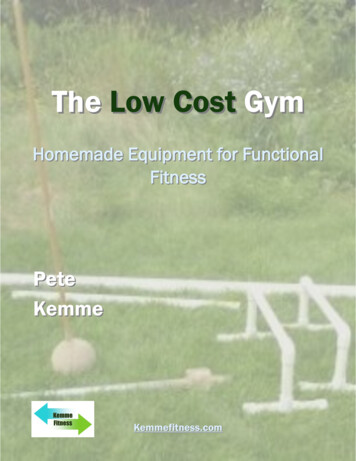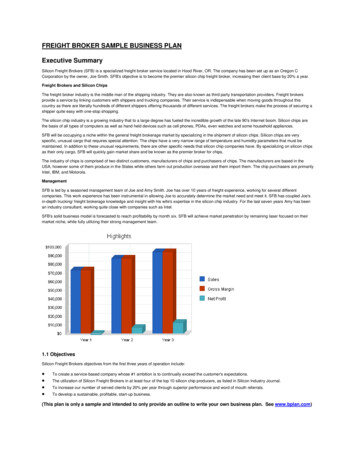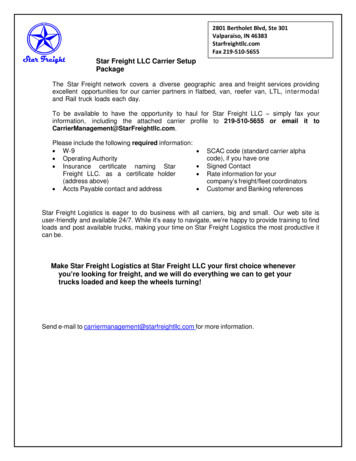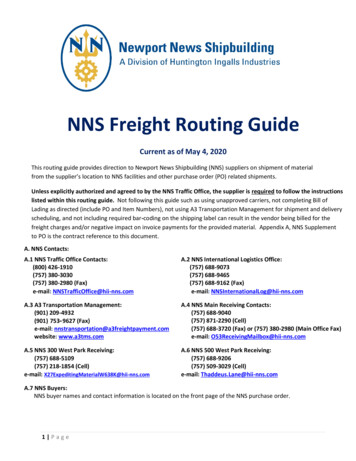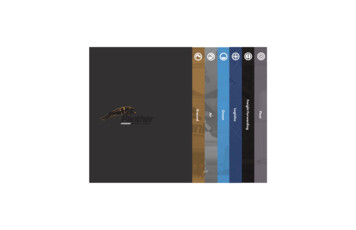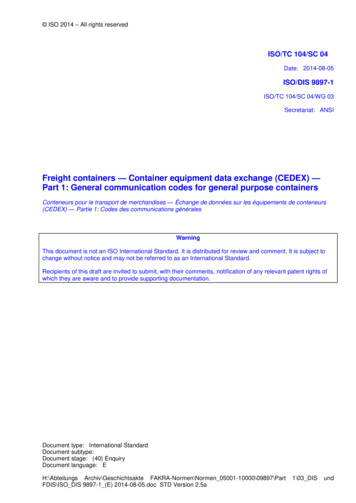
Transcription
ISO 2014 – All rights reservedISO/TC 104/SC 04Date: 2014-08-05ISO/DIS 9897-1ISO/TC 104/SC 04/WG 03Secretariat: ANSIFreight containers — Container equipment data exchange (CEDEX) —Part 1: General communication codes for general purpose containersConteneurs pour le transport de merchandises — Échange de données sur les équipements de conteneurs(CEDEX) — Partie 1: Codes des communications généralesWarningThis document is not an ISO International Standard. It is distributed for review and comment. It is subject tochange without notice and may not be referred to as an International Standard.Recipients of this draft are invited to submit, with their comments, notification of any relevant patent rights ofwhich they are aware and to provide supporting documentation.Document type: International StandardDocument subtype:Document stage: (40) EnquiryDocument language: EH:\Abteilungs Archiv\Geschichtsakte FAKRA-Normen\Normen 05001-10000\09897\PartFDIS\ISO DIS 9897-1 (E) 2014-08-05.doc STD Version 2.5a1\03 DISund
ISO/DIS 9897-1Copyright noticeThis ISO document is a Draft International Standard and is copyright-protected by ISO. Except as permittedunder the applicable laws of the user's country, neither this ISO draft nor any extract from it may be reproduced, stored in a retrieval system or transmitted in any form or by any means, electronic, photocopying,recording or otherwise, without prior written permission being secured.Requests for permission to reproduce should be addressed to either ISO at the address below or ISO'smember body in the country of the requester.ISO copyright officeCase postale 56 CH-1211 Geneva 20Tel. 41 22 749 01 11Fax 41 22 749 09 47E-mail copyright@iso.orgWeb www.iso.orgReproduction may be subject to royalty payments or a licensing agreement.Violators may be prosecuted.ii ISO 2014 – All rights reserved
ISO/DIS 9897-1ContentsPage1Scope . 12Normative references . 13Principle. 144.14.24.3Data elements and codes . 2Data elements . 2Data assignments . 2Updating data elements . 4Annex A (normative) Code - Message types . 5Annex B (normative) Structural condition, repair condition, outside coating, inside coating, full/empty indicator . 6B.1Structural condition, repair condition, outside coating, inside coating . 6B.2Full/empty indicator . 6Annex C (normative) Damage Location . 7C.1Location coding convention. 7Annex D (normative) Damage types . 12Annex E (normative) Material types . 16Annex F (normative) Repair types . 17Annex G (normative) Measure unit specifier, repair size dimension and work scales . 21G.1Measure unit specifier. 21G.2Size of repair . 22G.3Scale . 22Annex H (normative) Responsibility . 23Annex I (normative) Components of the general purpose container. 24I.1Components of general purpose containers . 24I.2Components applicable to marking . 33I.3Miscellaneous . 35Bibliography . 41 ISO 2014 – All rights reservediii
ISO/DIS 9897-1ForewordThis first edition of ISO 9897-1, together with ISO 9897-2, ISO 9897-3, ISO 9897-4, ISO 9897-5 and ISO9897-6, cancels and replaces ISO 9897:1997. Together with a thoroughly technical revision of the ISO9897:1997, this international standard have been split into parts to simplify and relate the technical content ofeach part to each type of container and also, as far as possible, to harmonize the parts of ISO 9897 with theorder of container types as contained in the parts of ISO 1496.ISO (the International Organization for Standardization) is a worldwide federation of national standards bodies(ISO member bodies). The work of preparing International Standards is normally carried out through ISOtechnical committees. Each member body interested in a subject for which a technical committee has beenestablished has the right to be represented on that committee. International organizations, governmental andnon-governmental, in liaison with ISO, also take part in the work. ISO collaborates closely with the International Electrotechnical Commission (IEC) on all matters of electrotechnical standardization.International Standards are drafted in accordance with the rules given in the ISO/IEC Directives, Part 2.The main task of technical committees is to prepare International Standards. Draft International Standardsadopted by the technical committees are circulated to the member bodies for voting. Publication as an International Standard requires approval by at least 75 % of the member bodies casting a vote.Attention is drawn to the possibility that some of the elements of this document may be the subject of patentrights. ISO shall not be held responsible for identifying any or all such patent rights.ISO 9897-1 was prepared by Technical Committee ISO/TC 104, Freight containers, Subcommittee SC 04,Identification and communication.This first edition of ISO 9897-1, together with ISO 9897-2, ISO 9897-3, ISO 9897-4, ISO 9897-5 and ISO9897-6, cancels and replaces ISO 9897:1997. Together with a thoroughly technical revision of the ISO9897:1997, this international standard have been split into parts to simplify and relate the technical content ofeach part to each type of container and also, as far as possible, to harmonize the parts of ISO 9897 with theorder of container types as contained in the parts of ISO 1496.ISO 9897 consists of the following parts, under the general title Freight containers — Container equipmentdata exchange (CEDEX): Part 1: General communication codes for general purpose containers Part 2: Refrigerated containers Part 3: Tank Part 4: Special purpose containers Part 5: Chassis Part 6: Message sets for data transfer between trading partners and systemsiv ISO 2014 – All rights reserved
DRAFT INTERNATIONAL STANDARDISO/DIS 9897-1Freight containers — Container equipment data exchange(CEDEX) — Part 1: General communication codes for generalpurpose containers1ScopeThis International Standard specifies general communication codes for container equipment data exchange(CEDEX).It is intended for business entities for use in communications relating to freight container transactions.2Normative referencesThe following referenced documents are indispensable for the application of this document. For dated references, only the edition cited applies. For undated references, the latest edition of the referenced document(including any amendments) applies.ISO 3166:1993, Codes for the representation of names of countriesISO 6346:1995, Freight containers — Coding, identification and markingISO 9897-6:2010, Freight containers — Container equipment data exchange (CEDEX) — Message sets fordata transfer between trading partners and systemsUN/C-FACT Draft Directory and Standard Directory3PrincipleIn ISO 9897, codes are assigned to pieces of information, called "data elements", which are commonly usedin transactions relating to freight containers. These data elements are named and defined, and each elementis assigned a CEDEX alphabetical or alphanumeric code. Separate code lists for each type of information(damage, component, repair, location, etc.) are maintained. A code may be reused in several different codelists, but a code is never used for more than one data element within a single code list.The data element may be phrased about material of construction of a container. For example, CEDEX code"LS" in material type code list (Annex E) stands for "wood, soft laminated plank". A code may define the component of the container that is damaged, its location, or its operating defect, depending on which data elementis being defined. A selection is made from the appropriate code list to indicate which component, location, ordefect, respectively, is chosen. Other coded data elements indicate essential physical characteristics of thecontainer and information pertinent to the use and management of the container, such as names and addresses of owners.It can be seen from these examples that the text of a message can be substantially reduced in length by usingthe CEDEX codes instead of plain language. Use of the CEDEX codes results in messages much reduced inlength, transmission time and communication cost, yet conveying information as complete as a much longerplain-language message.Through proper programming of a computer, a CEDEX-encoded message can be printed out in plain language for the benefit of the communicators, if so desired, or it can be left in its encoded form. The personnelusing the code routinely will develop the skill of being able to read messages in coded form; in fact, experi- ISO 2014 – All rights reserved1
ISO/DIS 9897-1ence using the code has borne out this assertion. Also, many operators will not require use of all CEDEXcodes assigned in ISO 9897, but only a portion of them due to the limited variety of containers and chassis intheir domain.Specific information about manufacturer, type and model of a container or chassis and its equipment is contained in the message, see 4.2.2.4Data elements and codes4.1 Data elementsData elements and corresponding code sets required to describe equipment components, their condition,repair methods, etc., are included in the appropriate Annex shown in table 1.4.2 Data assignments4.2.1CEDEX codesAll codes assignments of CEDEX shall be taken as obligatory. That is, an operator shall not pick and choosealternative codes unilaterally, nor depart from the established protocol, nor introduce new codes without having registered the codes in accordance with 4.3.However, two trading partners may agree mutually to use alternative codes if necessary code are not includedin this standard. It is strongly recommended that such code be registered in accordance with 4.3 as soon aspossible after introduction.4.2.2Message setsMessage sets as per ISO 9897-6 are alternative interface messages used for electronic data interchangetransmission. An owner or operator can pick and choose amongst other standards and the standard serves asa list of required and optional data elements.The specific information about manufacturer, type and model of a container or chassis and its equipment iscontained in the message sets.Annex A of ISO 9897-6 is normative; it describes the manner in which a directory of users is developed. Thedirectory is maintained by BIC – Bureau International des Containers listed as BIC-LOCODES at www.biccode.org.2 ISO 2014 – All rights reserved
ISO/DIS 9897-1Table 1 — Data elements and code setsData elementsCode setSee AnnexMessage typeAFull/empty indicator (container)BStructural condition (container)BRepair condition (container)BOutside coating (container)BInside coating (container)BDamage locationCDamage typeDMaterial typeERepair typeFMeasure unit specifierGWork scale (standard time factor)GResponsibility (for repair action)HComponent for containerI ISO 2014 – All rights reserved3
ISO/DIS 9897-14.3 Updating data elementsThe ISO Council has, in accordance with the provisions of the Directives for the technical work of ISO, designated the Bureau International des Containers (BIC) as the Registration Authority for the data elements:Registration Authority for ISO 9897
ISO 3166:1993, Codes for the representation of names of countries ISO 6346:1995, Freight containers — Coding, identification and marking ISO 9897-6:2010, Freight containers — Container equipment data exchange (CEDEX) — Message sets for data transfer between trading partners and systems UN/C-FACT Draft Directory and Standard Directory 3 .
